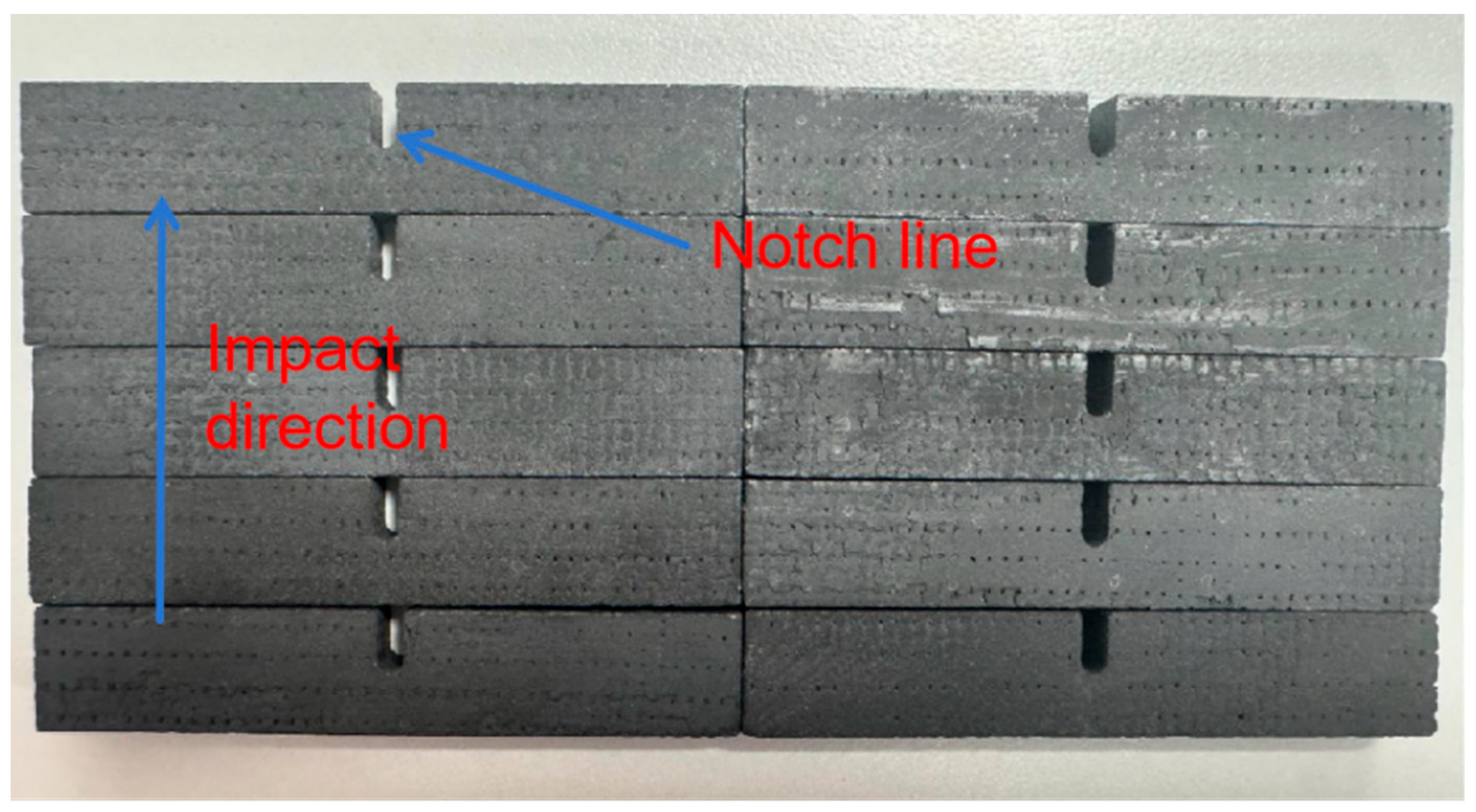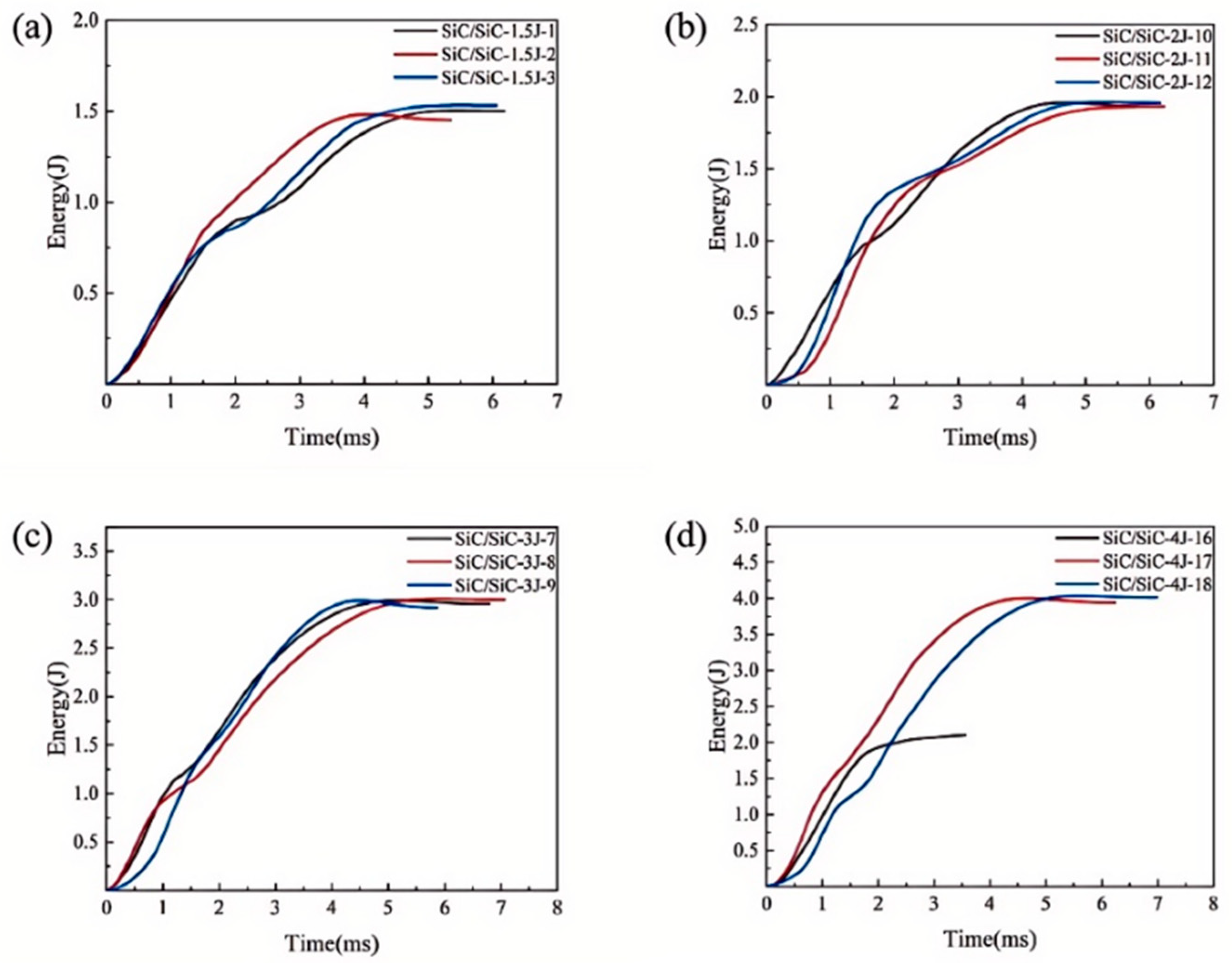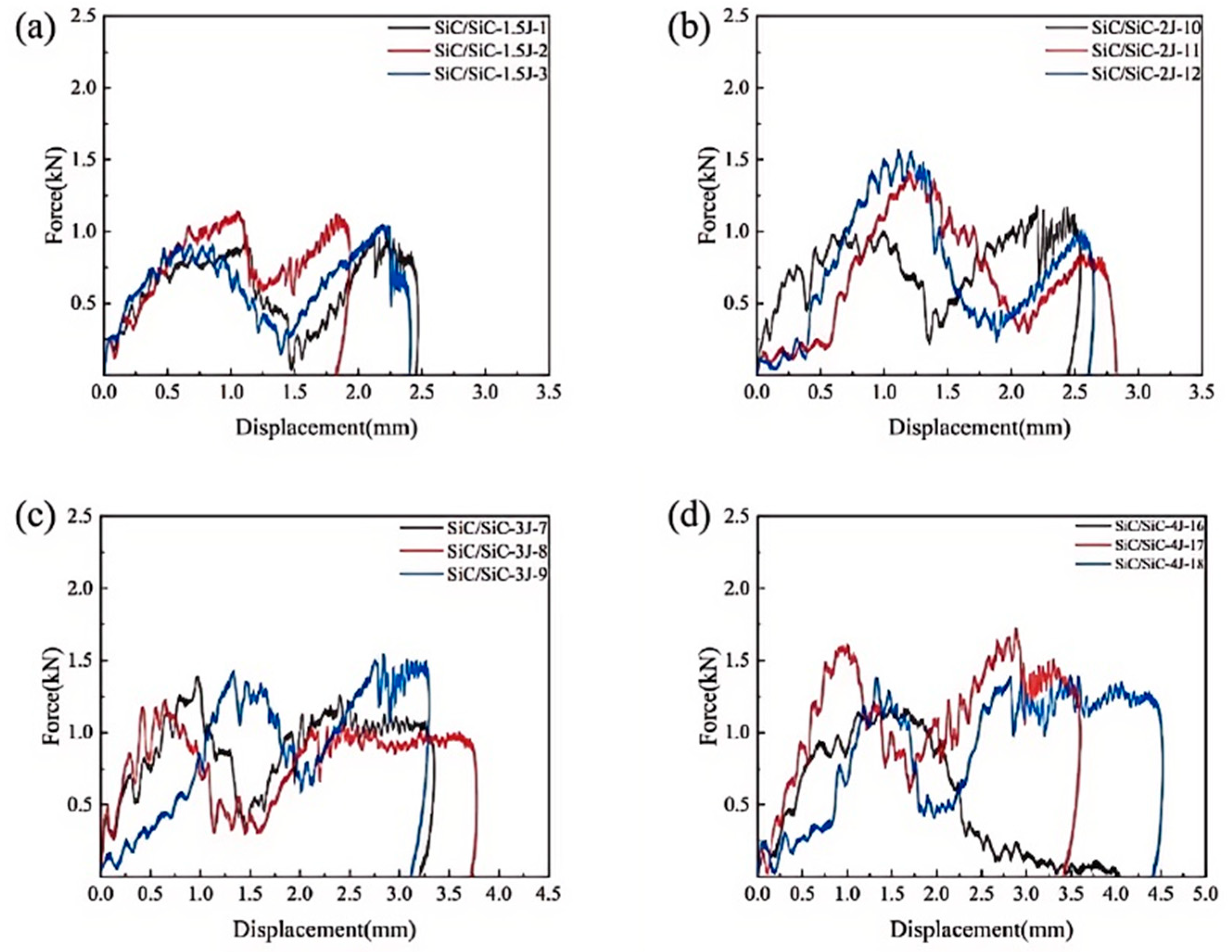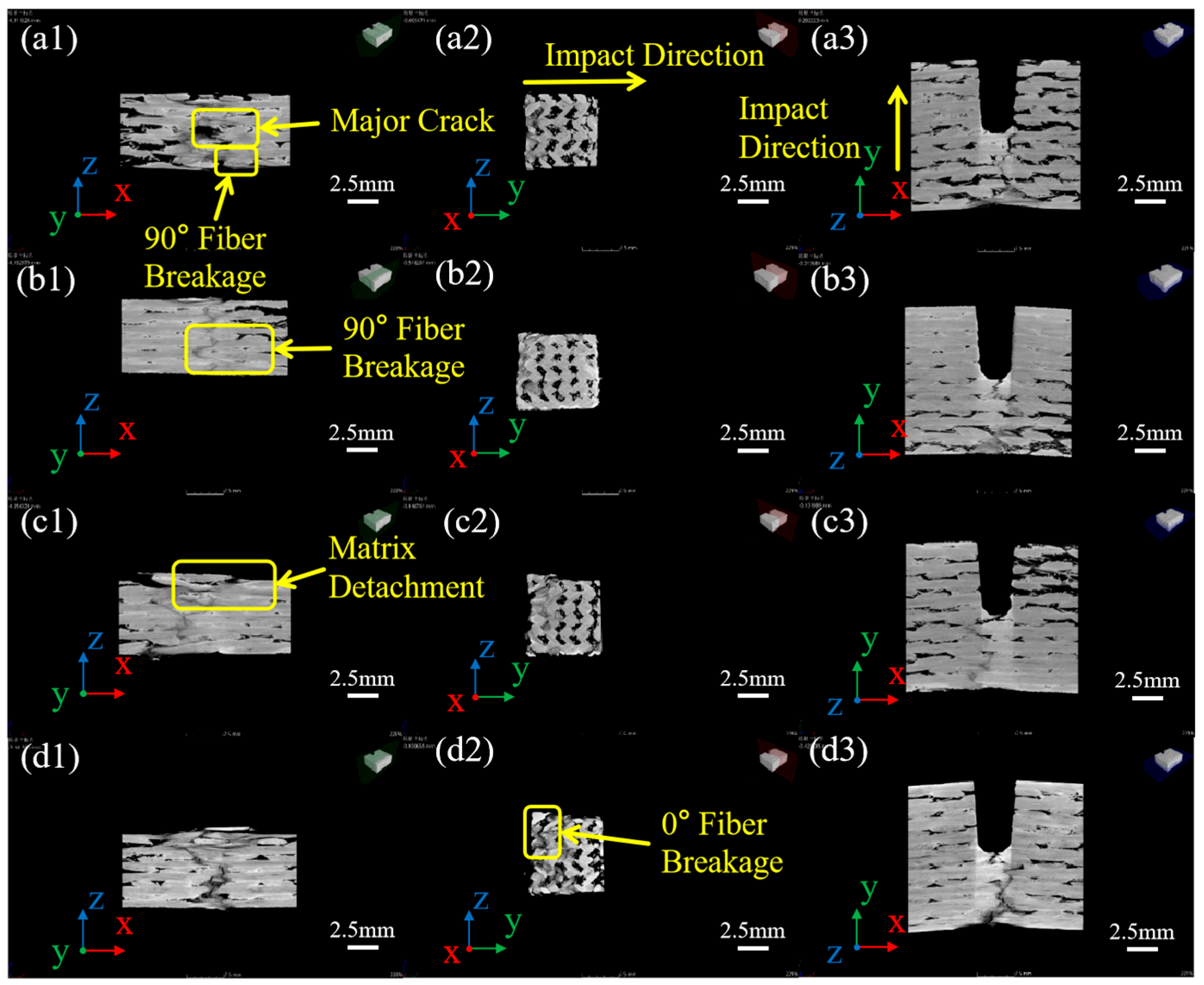Low-Velocity Impact Damage Behavior and Failure Mechanism of 2.5D SiC/SiC Composites
Abstract
1. Introduction
2. Materials and Test Methods
2.1. Sample Preparation
2.2. Impact Test
2.3. Impact Damage Detection
3. Results and Discussion
3.1. Impact Response Process
3.2. Impact Damage
3.2.1. Effect of Impact Energy
3.2.2. Effect of Impact Times
4. Conclusions
Author Contributions
Funding
Data Availability Statement
Acknowledgments
Conflicts of Interest
Appendix A
| Sample | Impact Energy/J | Er/% | Etr/% | ∆h/mm | Case of Sample Fracture |
|---|---|---|---|---|---|
| 1 | 1.5 | 99.88 | / | 2.453 | Unbroken |
| 2 | 1.5 | 98.19 | / | 1.823 | Unbroken |
| 3 | 1.5 | 99.97 | / | 2.402 | Unbroken |
| 4 | 1.5(1) | 95.74 | 97.86 | 2.738 | Unbroken |
| 1.5(2) | 99.98 | 2.851 | Broken | ||
| 5 | 1.5(1) | 97.64 | 97.21 | 1.558 | Unbroken |
| 1.5(2) | 96.77 | 2.478 | Unbroken | ||
| 6 | 1.5(1) | 99.97 | 99.16 | 2.008 | Unbroken |
| 1.5(2) | 98.34 | 2.303 | Unbroken | ||
| 7 | 3 | 99.02 | / | 3.206 | Unbroken |
| 8 | 3 | 99.78 | / | 3.724 | Unbroken |
| 9 | 3 | 97.80 | / | 3.118 | Broken |
| 10 | 2 | 98.83 | / | 2.442 | Unbroken |
| 11 | 2 | 99.95 | / | 2.827 | Unbroken |
| 12 | 2 | 99.68 | / | 2.610 | Unbroken |
| 13 | 2(1) | 97.73 | 95.91 | 1.999 | Unbroken |
| 2(2) | 94.09 | 1.626 | Broken | ||
| 14 | 2(1) | 99.85 | 99.40 | 2.831 | Unbroken |
| 2(2) | 98.95 | 2.516 | Unbroken | ||
| 15 | 2(1) | 99.23 | 98.46 | 2.260 | Unbroken |
| 2(2) | 97.69 | 1.911 | Unbroken | ||
| 16 | 4 | 53.03 | / | 4.039 | Broken |
| 17 | 4 | 98.67 | / | 3.412 | Unbroken |
| 18 | 4 | 99.48 | / | 4.413 | Unbroken |
References
- Zhao, Z.; Zhu, L.; Xu, P.; Ning, J.; Yang, Z. Effect of SiC content on the process and properties of PDMS/SiC composites by direct ink writing. Ceram. Int. 2025, 51, 5241–5248. [Google Scholar] [CrossRef]
- Zhang, S.; Gao, X.; Chen, J.; Dong, H.; Song, Y. Strength model of the matrix element in SiC/SiC composites. Mater. Des. 2016, 101, 66–71. [Google Scholar] [CrossRef]
- Han, X.; Gao, X.; Song, Y. Effect of heat treatment on the microstructure and mechanical behavior of SiC/SiC mini-composites. Mater. Sci. Eng. A 2018, 746, 94–104. [Google Scholar] [CrossRef]
- Frankel, P.; Withers, P.; Preuss, M.; Wang, H.; Tong, J.; Rugg, D. Residual stress fields after FOD impact on flat and aerofoil-shaped leading edges. Mech. Mater. 2012, 55, 130–145. [Google Scholar] [CrossRef]
- Yin, D.; Deng, Y.; Ma, Y.; Fan, X. Effect of SiC content on the mechanical behaviour of a three-dimensional needled C/SiC composite. Ceram. Int. 2021, 47, 25067–25073. [Google Scholar] [CrossRef]
- Mei, H.; Yu, C.; Xu, Y.; Han, D.; Cheng, L. Effect of impact energy on damage resistance and mechanical property of C/SiC composites under low velocity impact. Mater. Sci. Eng. A 2017, 687, 141–147. [Google Scholar] [CrossRef]
- Yao, L.; Lyu, P.; Bai, G.; Augousti, A. Influence of low velocity impact on oxidation performance of SiC coated C/SiC composites. Ceram. Int. 2019, 45, 20470–20477. [Google Scholar] [CrossRef]
- Neto, J.; da Cunha, R.; Targino, T.; da Cunha, R.; de Amorim Jr, W.; Freire, R., Jr. Study of the Mechanical Behavior of Low-Velocity Impact Loading in the Presence of Stress Concentrators. J. Mater. Eng. Perform. 2023, 32, 10783–10792. [Google Scholar] [CrossRef]
- Kharghani, N.; Guedes Soares, C. Behavior of composite laminates with embedded delaminations. Compos. Struct. 2016, 150, 226–239. [Google Scholar] [CrossRef]
- Chen, X. Foreign object damage on the leading edge of a thin blade. Mech. Mater. 2005, 37, 447–457. [Google Scholar] [CrossRef]
- Ding, J.; Hall, R.; Byrne, J.; Tong, J. Fatigue crack growth from foreign object damage under combined low and high cycle loading. Part 1: Experimental studies. Int. J. Fatigue 2007, 29, 1339–1349. [Google Scholar] [CrossRef]
- Ogi, K.; Okabe, T.; Takahashi, M.; Yashiro, S.; Yoshimura, A.; Ogasawara, T. Experimental characterization of high-speed impact damage behavior in a three-dimensionally woven SiC/SiC composite. Compos. Part A 2010, 41, 489–498. [Google Scholar] [CrossRef]
- Herb, V.; Martin, E.; Couegnat, G. Damage analysis of thin 3D-woven SiC/SiC composite under low velocity impact loading. Compos. Part A 2012, 43, 247–253. [Google Scholar] [CrossRef]
- Wu, J.; Xu, P.; Jing, R.; Zhang, D.; Fei, Q. Experimental Study on Low-velocity Impact and Residual Strength of SiC/SiC Composite Laminates. J. Inorg. Mater. 2024, 39, 51–60. [Google Scholar] [CrossRef]
- Chen, M.; Qiu, H.; Chen, Y.; Zhang, Q.; Liu, S. Study on fracture toughness and impact toughness of SiCf/SiC composites. J. Aust. Ceram. Soc. 2023, 59, 325–332. [Google Scholar] [CrossRef]
- Liu, B.; Gao, Y.; Tan, Z.; Ye, F.; Cheng, L. Low energy level impact damage on 2D C/SiC composites: Experimental study. Acta Aeronaut. Astronaut. Sin. 2021, 42, 224202. [Google Scholar]










| Sample | Impact Energy/J | Er/% | Etr/% | ∆h/mm | Case of Sample Fracture |
|---|---|---|---|---|---|
| 1 | 1.5 | 99.88 | / | 2.453 | Unbroken |
| 4 | 1.5(1) | 95.74 | 97.86 | 2.738 | Unbroken |
| 1.5(2) | 99.98 | 2.851 | Broken | ||
| 9 | 3 | 97.80 | / | 3.118 | Broken |
| 10 | 2 | 98.83 | / | 2.442 | Unbroken |
| 13 | 2(1) | 97.73 | 95.91 | 1.999 | Unbroken |
| 2(2) | 94.09 | 1.626 | Broken | ||
| 16 | 4 | 53.03 | / | 4.039 | Broken |
Disclaimer/Publisher’s Note: The statements, opinions and data contained in all publications are solely those of the individual author(s) and contributor(s) and not of MDPI and/or the editor(s). MDPI and/or the editor(s) disclaim responsibility for any injury to people or property resulting from any ideas, methods, instructions or products referred to in the content. |
© 2025 by the authors. Licensee MDPI, Basel, Switzerland. This article is an open access article distributed under the terms and conditions of the Creative Commons Attribution (CC BY) license (https://creativecommons.org/licenses/by/4.0/).
Share and Cite
Tu, J.; Duan, X.; Luan, X.; He, D.; Cheng, L. Low-Velocity Impact Damage Behavior and Failure Mechanism of 2.5D SiC/SiC Composites. J. Compos. Sci. 2025, 9, 388. https://doi.org/10.3390/jcs9080388
Tu J, Duan X, Luan X, He D, Cheng L. Low-Velocity Impact Damage Behavior and Failure Mechanism of 2.5D SiC/SiC Composites. Journal of Composites Science. 2025; 9(8):388. https://doi.org/10.3390/jcs9080388
Chicago/Turabian StyleTu, Jianyong, Xingmiao Duan, Xingang Luan, Dianwei He, and Laifei Cheng. 2025. "Low-Velocity Impact Damage Behavior and Failure Mechanism of 2.5D SiC/SiC Composites" Journal of Composites Science 9, no. 8: 388. https://doi.org/10.3390/jcs9080388
APA StyleTu, J., Duan, X., Luan, X., He, D., & Cheng, L. (2025). Low-Velocity Impact Damage Behavior and Failure Mechanism of 2.5D SiC/SiC Composites. Journal of Composites Science, 9(8), 388. https://doi.org/10.3390/jcs9080388





